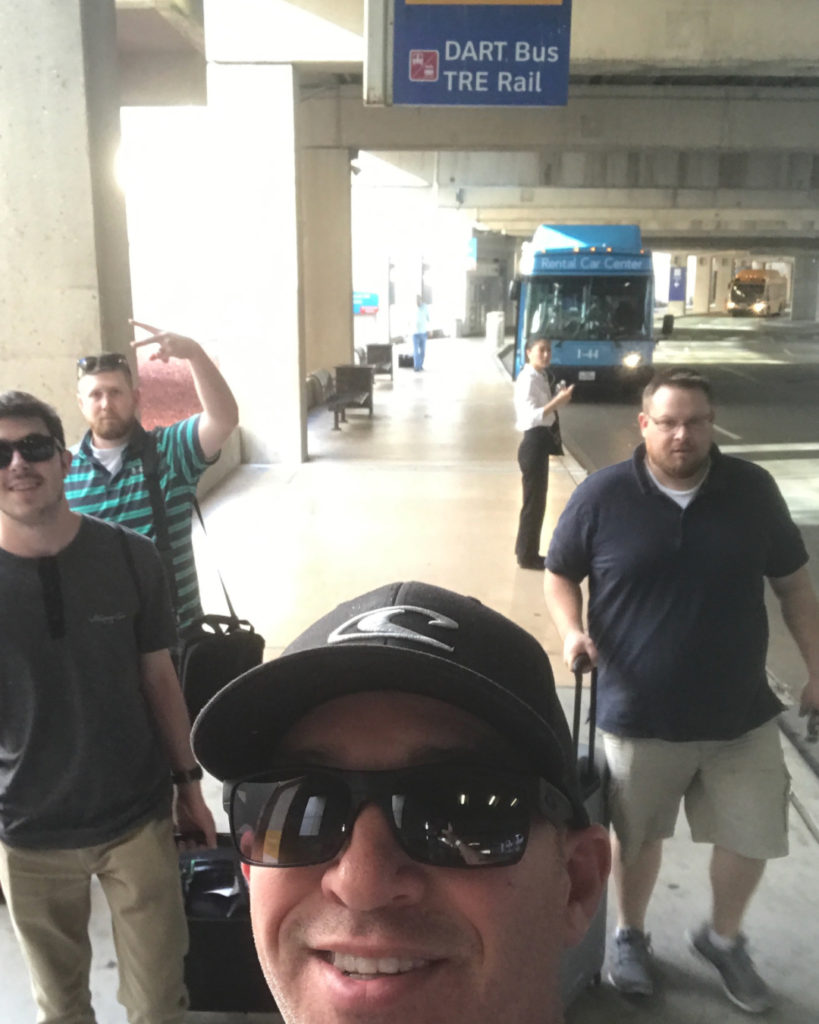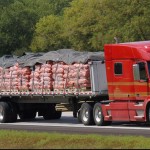Featured image: Cain Adams with wife, Cheryl at San Diego Beach, CA
As part of the nationwide Trinity Logistics operation, Cain Adams at Longboard Logistics in Boise, ID, finds himself wearing an assortment of hats. But that comes pretty naturally for the Army veteran who tested the M1A2 Abrams Battle Tank prior to earning a Bachelor’s Degree in Wine Marketing and, in this exact order, becoming a husband and father. His story is fascinating, and OnionBusiness is pleased both to share it and a new installment to our newsletter line-up – a periodic logistics perspective.
A bit about Trinity, which is a leading third-party logistics company that specializes in freight arrangement and supply chain solutions that started four decades ago. Founded in 1979 by Ed and Deana Banning as a family operation called Trinity Transport, the company today – Trinity Logistics – has upwards of 300 team members in five regional service center locations, and there are 100 agent offices across the country.
The Boise team’s agent office is Longboard Logistics, and in addition to Cain, the team members are Cain’s corporate partner, Nathaniel Farson, as well as Kirk Tewalt, Austin Lee and Itzie Lugo. The mix brings together “five totally different personalities,” as Cain notes, and the specialty is produce.
Cain said he wasn’t born to the industry, and in fact moving to Boise “was a lifestyle change,” but he explained that the job market was tough in 2008. He didn’t start at Trinity but rather at a company that propelled him into the freight logistics universe.
“Enjoying numbers, I answered an ad for a broker position,” he said of the 2008 entree. “Dressed up for my interview, I entered an office with guys dressed in tee shirts and shorts. I thought I was at a surfer’s convention.” Thinking he was interviewing for a stock brokers position, Cain was intrigued with the reality of freight brokering.

“The phones were ringing, and it was fast. It was a rush just to see it all take place. I went home and studied all night to figure out what it would take to do this job. Coming back the next day, I was given the chance to make some calls. Jeremy Teeples, with Kingston, gave me my first reefer load. He also gave me his friendship. I am forever grateful to this dude.”
Cain’s previous experience clicked with the pace, and maybe by design his pathway to working logistics was circuitous.
“Over the years I was a rolling stone calling Sonoma County, CA, Maui, HI, Fort Hunter, Liggett CA, Gainesville, FL, Santa Cruz, CA, Atlanta, GA, St. Petersburg, FL, and finally Boise. Each move gave me opportunity and life skills I would never give back. I hold a Bachelor in Wine Marketing from Sonoma State University, paid for by the United States Army for my service as an Armor Crewman testing the M1A2 Abrams Battle Tank. I put my degree to use working with Barefoot Wine. It was a great ride until sold to Gallo. The wine industry has changed a ton, and my CEO was spot on with margins dropping and increased competition.”
And there’s family. “After finding out we were having a little girl, I up-rooted my family from Tampa and headed to the number-one place to live in the United States. Boise. That was 11 years ago. Time flies,” he said.
The first freight office that launched Cain’s logistics career was not a good fit, and he said it ultimately folded. He said, “Ethics is a big deal to me, and I like to sleep at night knowing I did the right thing. I resigned from being a freight broker agent because I thought it was not for me.”
However, his friend Jeremy Teeples convinced him to open his own office, and Teeples said “he would send customers my way.” And “that’s when everything clicked,” Cain said. “I became a broker agent for England Logistics, leased a small commercial space, and the orders came over. I hired Nathaniel Farson, a native of Boise and one of the best people I know. Nathaniel is a talented guy who graduated from the University of Idaho. He is a driven individual with passion and depth. Moreover, Nathaniel is honest and fair.”
With changes at England Logistics, Cain and Nathaniel “looked around and found Trinity Logistics,” Cain said.
It was 2009, and the men decided, “Trinity had everything we needed and more. Their reputation for doing the right thing shined. We signed up, and it has been a wonderful relationship for our agent office named Longboard Logistics.”
The name? “I called it Longboard Logistics because it feels like we surf freight coast to coast. We are fast and furious yet careful as possible, making sure we get the load delivered like a sweet ride. California is a bad word in Idaho, but some things, like waves in California, Hawaii and Florida are hard to give up for me. This job is a rush. Each day can bring huge waves of freight. With that comes a different kind of stress.”
He added, “It’s not a bad stress if you know how to negotiate the ups and downs. This is what we do. We negotiate, we turn bad stress into high fives, and we don’t over promise and underperform. We are human, and we fall now and then but we can rest at night knowing we did everything we could for the customer – the customer being both the person sending us the order and the carrier who we coordinate the shipment with. We love what we do and I for one am thankful each day for the opportunities given to me.”
Cain said the team is “five totally different personalities who work close with customers to provide transportation support out of all onion growing regions in the U.S. and border crossings with Mexico and Canada. We move other produce products, including melons, apples, potatoes, carrots and hops.”
For onions, Longboard uses “Refrigerated, Vans, Conestoga and Flats,” and Cain said, “Each customer has their own preference. They compete, and sometimes one mode of transportation costs less than another allowing them a competitive edge.”
While logistics is a big world, Cain said in half-jest, “Meteorologist should be our second title. I swear, we could get a meteorologist job if freight ever becomes automated. It’s our job to look ahead and use the most effective routes to keep quality intact. Quality is crucial and the most important element, in my opinion, other than being on time with the delivery. Watching for moisture, loading correct and venting correct are elements we focus on to support a shipped fresh produce product like onions.”
And the team also notes the critical matters of onion pricing, gapping areas, saturation of the market and weather “to help us with freight rates.” He said, “We ask a lot of questions, and we listen.”
Some of Longboard’s customers have been shipping onions for decades, and Cain observed, “These old timers know when to buy two to three weeks before anyone else. Their ordering helps us understand what is ahead with pricing. When we see them stop ordering from a certain region, we know something is off so we ask.”
If they’re told, for instance, that “New Mexico is going to gap next week,” the team knows “to watch California and other growing areas.” He said, “The other growing areas will get called on and in turn increase the demand for trucks. We then know the rate for those trucks will go up. If we are pulling a load from a gapping area, we know the rate in that area will be lower. If an area gets rain, we know loading will take time and less loads will come out. Furthermore, we know this can affect the types of equipment being used. Flatbeds will be pushed to the side, and reefers will be used more often. We need to watch these things to help customers’ price lanes, which allows them to sell a load to a customer at a fair market rate. If not informed, a customer could take it for granted, over a weekend, and price a lane too low. For instance, maybe the shipping lane from Washington to California changed because California slowed down with freight. Friday it was $1600.00, but Monday could bring a $2200.00 lane. We watch things close to educate.”

And at this time of year, Cain said, “We are watching California and the heat. We look for crops coming to an end. We watch what people are buying – books and school supplies not produce. We don’t just look at onions.”
He continued, “California is the ninth largest economy in the world. We can figure out how dead it is by simply posting a load to Chicago from Fresno. We know the lane pricing, and we know a lot of Russian drivers live in Chicago. They want to get home the most direct route. When we see a team load going for $3.75 per 50 on a reefer, we know its slowing down fast. If this happens, trucks will ask for more money to come back into California from Washington to make up the difference. We do this for many areas to see what is coming up.”
Several days prior to Dorian, Cain said, “Florida is another area to watch in a similar fashion. Certain times of the year the rate goes from 1.00 per mile coming out to $3.00 a mile coming out. During those $3.00 a mile periods, a customer can save thousands shipping into Florida! Trucks want in and they will take lower paying loads to get there.”
Cain commented on the intermodal Reload Facility proposed for Nyssa, OR, saying it’s “a great idea,” but he added, “I don’t know if they thought about the new Amazon distribution center coming into Nampa. If, and this is a big if, the Amazon distribution center brings trucks in, the pricing per load going out will go down.” He said additional commodities such as frozen product would be a good addition to the manifest at the site.
He also said that in addition to onions, the Walla Walla area “ships wine and other summer product which can get them through the year,” and he suggested “a study around Amazon distribution centers needs to be addressed.”
In addition to the predictable transportation issues that come during Christmas tree time, Cain said other products also factor into logistics. Apples and potatoes shipping from the Northwest “all at the same time” is one of those factors, and of course weather is another. And, he said, “Oct. 15 hits, and two things happen: Flatbeds are less likely to be used, and the snow is flying. Those two factors placed together creates a short if the load volume is the same and all loads are to be placed on reefers. Moreover, we watch the East and Southeast for hurricanes. If you see a hurricane land as a Cat 3 or above, get ready for freight prices to skyrocket into that area.”
FEMA pays trucks $5/mile to bring
needed supplies to the areas hit, and trucks “stay in the South and make a lot
of money fast,” Cain said. “They don’t have to make the voyage into the
Northwest from the South or the East, which is usually super low on rates anyway.
Less freight comes from the East than the West and can be half the rate per mile,
so they just stay put.”
Also, “When trucks become short, we do email blasts showing truckers some of the spot market rates coming out of the shipping regions and why they should come this way. We call our regulars and find out how they are doing and if they are coming this year. We try to find loads which will take them by their houses. When our phone rings we review area codes. We can tell by their area codes where they may want to go. Home sweet home.”
There’s no crystal ball, but customers, Cain said, listen to their phones, and “When they hear that phone ring and it’s 20 freight brokers calling them, in a row, they know freight volume is low, which can help get them a lower cost truck. When customers don’t hear from brokers and hear from their customers, they know onion prices are inching up, and demand for trucks will get tighter. They need to move fast. The best thing I can do is watch what will happen to fuel, weather, consumer spending, onion pricing, other commodity pricing, Mexico and growing and harvest times.”
Onion prices dropped in prices, he said, “because the weather was perfect in the Northwest and allowed the crop to be harvest early with great quality and size for most. This put pressure on the other growing regions which were finishing up. It’s hard for some sheds to not chase those double-digit profits and hold the pricing so they drop and sell.” And on the other hand, “Some guys won’t ship an onion until Oct. 1 because they don’t feel that firm thick skin until the cooler weather allows it to get there. It’s an amazing process.”
He said diesel fuel and the IMO 2020 standard, “which has been talked about since 2016,” will also have bearing. A Reuters story noted that global prices for diesel and marine fuels “should rise by October ahead of a January switch to new, very low-sulfur marine fuels, and remain higher for at least a year as refiners shift production to make more of the new fuels, analysts said.”
Ultimately, Cain said, “We cannot predict the future. All we can do is find freight solutions which meet our customers’ needs. We do however, try our best to look at events which may hedge our chances at better rates for our customers and trucks. We know there is nothing sexy about freight. We don’t sell anything cool. We stay under the radar and only work with a select few. It’s a crazy business but it’s exciting. Tomorrow may bring us waves of freight or it may bring us flat seas. Either way, we are here to enjoy both views and ride storms when they come.”


